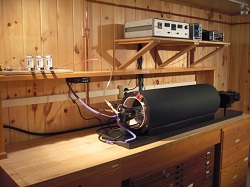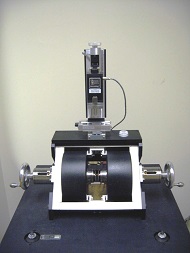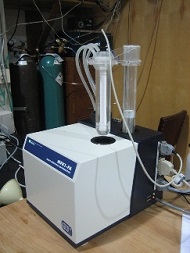Earth and Environmental Magnetism Laboratory (EEML)
(Dow 109A and 618)
We like talking about our research! If you are a student looking for a research project,
a professional, or just curious about science, we encourage you to contact Dr. Aleksey Smirnov
(asmirnov AT mtu.edu; 906-487-2365) to schedule a visit.
Meanwhile, check out the video below. Katie Bristol, an M.S. student who graduated in summer 2020, introduces our laboratory.
Katie is now a Ph.D. student at the University of Florida.
Here is an example of our outreach activities.
Read some additional stories under the links below:
North American Plate Shattered Speed Records - a Billion Years Ago
Clues to the Earth's Ancient Core
How Old is the Earth's Inner Core?
The Mantle Plume Model and Siberian ''Traps''
''The Great Dying''
Equipment
The EEML is a world-class laboratory equipped with state-of-the-art instruments
that allow us to conduct a wide range of magnetic measurements, including the entire spectrum of rock-, mineral-
and paleo-magnetic analyses.
|
2G Enterprises High-Resolution Superconducting Quantum Interference Device (SQUID) Rock Magnetometer.
The magnetometer is located inside a Lodestar Magnetics magnetostatic shield attenuating the ambient magnetic field to <300 nT throughout a walk-in working space (a shielded room). |

|
| 2G Enterprises 760-R three-axis Superconducting Quantum Interference Device (SQUID) Rock Magnetometer with in-line AF demagnetization system and automated sampling handling. The magnetometer is also equipped with an anhysteritic remanent magnetization (ARM) axial magnetizer and an isothermal remanent magnetization (IRM) pulse magnetizer. |

|
|
| ASC Model TD-48SC thermal specimen demagnetizer features three-layered shielding for effective internal field nullification and a compact sample chamber for minimal thermal gradients in the sample region. An additional fully enclosed sample chamber with gas ports allows optional treatment in a non-oxidizing atmosphere. The controlled field coil allows heating and cooling the samples in a homogeneous magnetic field up to 1 mT (10 Oe) to impart a partial or full thermal remanent magnetization for paleointensity determination experiments. The EML has two TD-48SC demagnetizers. |

|
|
| Princeton Measurement Corporation Model 2900 Alternating Gradient Field Magnetometer (AGFM). This powerful system for measuring the magnetic properties of a vast range of materials has extremely high sensitivity (10 nemu rms) and speed of measurement (100 ms per point). The maximum applied field is 1.4 Tesla. The properties measured include full and partial magnetic hysteresis loops, first-order reversal curves (FORC), backfield demagnetization curves, isothermal remanent magnetization (IRM) acquisition curves, etc. The AGFM also allows measurement of magnetic parameters as a function of time. The AGFM's MicroMag software allows separation of ferromagnetic, paramagnetic, and diamagnetic components, among many other functions. |

|
|
| AGICO (Advanced Geoscience Instruments Company) MFK1-FA Kappabridge equipped with a CS-3 Furnace Apparatus and a CS-L Cryostat. The MFK1-FA Kappabridge is the most sensitive (10^-8 SI) commercially available system for measuring bulk susceptibility in weak variable magnetic fields, operating at three different frequencies. The instrument also features rapid automatic measurement of the anisotropy of magnetic susceptibility. Utilization of the furnace and cryostat allows the measurement of temperature variation of bulk susceptibility within a broad temperature range from -196°C to 700°C, in air or flowing argon atmospheres. |

|
|
|
Our other instruments are an Applied Physics System Model 520 Three-Axis Fluxgate Magnetometer,
a Sapphire Instruments SI-4 AF Demagnetizer with ARM option, a Sapphire Instruments SI-6 Pulse
Magnetizer capable of 1100 mT peak induction. Our Princeton Applied Research vibrating sample
magnetometer with Edwards high vacuum system and Alpha 10 kilogauss electromagnet has been recently
relocated to the Material Science Building.
The EML paleomagnetic field sampling equipment includes:
|
